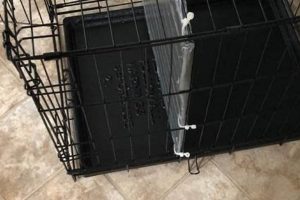Homemade, chilled edibles prepared specifically for canine consumption offer a refreshing and healthful alternative to commercially produced snacks. These customized recipes often incorporate readily available ingredients such as fruits, vegetables, yogurt, and peanut butter, tailored to meet a dog’s dietary needs and preferences.
The creation of these frozen canine snacks promotes pet owner engagement and control over ingredient quality, mitigating concerns associated with artificial additives and preservatives commonly found in mass-produced items. Furthermore, these chilled snacks can provide hydration, particularly beneficial during warmer seasons, and offer mental stimulation through the act of consumption. The practice also supports cost savings compared to purchasing pre-made options.
The subsequent discussion will delve into specific recipe suggestions, safety considerations regarding ingredients, and practical tips for preparation and storage, allowing readers to create these beneficial items.
Tips for Crafting Homemade Frozen Canine Confections
Optimizing the creation of frozen edible items for dogs involves careful consideration of ingredients, preparation techniques, and storage methods. The following recommendations aim to enhance safety, palatability, and nutritional value.
Tip 1: Ingredient Selection. Prioritize dog-safe components. Grapes, raisins, chocolate, onions, and garlic are toxic and must be strictly avoided. Opt for ingredients such as plain yogurt, unsweetened applesauce, pumpkin puree, and peanut butter (xylitol-free).
Tip 2: Portion Control. Canine frozen edibles should be offered as treats, not meal replacements. Adjust serving sizes based on the dogs size, age, activity level, and overall diet to prevent overfeeding and potential digestive upset.
Tip 3: Gradual Introduction. Introduce new ingredients slowly and individually to monitor for any allergic reactions or sensitivities. Observe the dog for signs of digestive distress, such as vomiting or diarrhea, after initial consumption.
Tip 4: Preparation Technique. Thoroughly wash all fruits and vegetables before incorporating them into recipes. Consider pureeing ingredients to create a smoother consistency, especially for smaller dogs or those with dental issues.
Tip 5: Freezing Methods. Utilize ice cube trays, silicone molds, or small containers for portioning. Ensure that the mixture is evenly distributed and frozen solid before serving. Avoid sharp edges on molds to prevent injury.
Tip 6: Storage Protocols. Store frozen canine edibles in airtight containers or freezer bags to prevent freezer burn and maintain freshness. Label containers with the date of preparation for optimal quality control.
Tip 7: Thawing Considerations. While typically served frozen, slightly thawing hard treats for a few minutes before serving might be better for dogs with sensitive teeth. Monitor the dog while consuming to prevent choking hazards if the treat is too large.
Adhering to these tips promotes the creation of safe, nutritious, and palatable frozen treats, fostering both canine well-being and pet owner satisfaction.
The subsequent sections will explore specific recipes, addressing ingredient variations and customization options to cater to individual canine preferences and dietary requirements.
1. Ingredient Safety
Ingredient safety is of paramount importance when preparing homemade frozen edibles for canine consumption. Unlike commercially produced dog treats, homemade options place the responsibility of ingredient selection and quality control squarely on the pet owner, necessitating a comprehensive understanding of canine dietary needs and potential toxins.
- Prohibited Substances
Certain substances are inherently toxic to dogs and must be strictly avoided. Chocolate, containing theobromine, poses a significant risk of cardiac and neurological damage. Grapes and raisins can induce acute kidney failure. Onions and garlic, even in small quantities, can cause anemia due to the breakdown of red blood cells. Xylitol, an artificial sweetener, is severely toxic and can lead to hypoglycemia and liver failure. Adherence to this exclusion principle is fundamental to ensure canine health.
- Allergenic Considerations
Dogs, like humans, can exhibit allergic reactions to various food items. Common canine allergens include wheat, corn, soy, dairy, and certain proteins like chicken or beef. When introducing new ingredients, it is imperative to do so gradually and observe the dog for any signs of allergic reaction, such as skin irritation, gastrointestinal upset, or respiratory distress. Hypoallergenic alternatives, such as sweet potato or rice flour, may be used for dogs with known sensitivities.
- Contamination Risks
Even ostensibly safe ingredients can pose risks if contaminated with bacteria, mold, or pesticides. Thoroughly washing all fruits and vegetables before use is essential to remove surface contaminants. Select fresh, high-quality ingredients from reputable sources to minimize the risk of spoilage and potential mycotoxin exposure. Proper storage of ingredients is also crucial to prevent mold growth.
- Nutritional Imbalances
While ingredient safety focuses on avoiding harmful substances, nutritional balance ensures the edible item contributes positively to the dog’s overall diet. Excessive amounts of sugar, salt, or fat can lead to health problems such as obesity, diabetes, and pancreatitis. The ideal frozen edible should complement the dog’s regular meals and provide a source of vitamins, minerals, and fiber without disrupting their nutritional equilibrium.
The convergence of these safety aspects directly influences the health and well-being of dogs consuming homemade frozen edibles. Diligence in ingredient selection, awareness of potential allergens, meticulous hygiene practices, and a focus on nutritional balance are critical for creating safe and beneficial treats. Failure to address these considerations can lead to adverse health outcomes, underscoring the importance of informed decision-making in the preparation process.
2. Nutritional Balance
Maintaining nutritional balance within homemade frozen canine edibles directly affects canine health and well-being. The composition of these treats should complement a dog’s primary diet, avoiding excess calories or nutritional deficiencies. An imbalance can lead to weight gain, digestive upset, or exacerbate existing health conditions. For instance, a frozen treat consisting solely of fruit, while seemingly healthy, may provide excessive sugar, impacting blood glucose levels, particularly in diabetic dogs. A more balanced approach incorporates protein sources like plain yogurt or peanut butter, alongside moderate amounts of dog-safe fruits and vegetables. The proportion of ingredients is a critical determinant of the treat’s impact.
The implications of imbalanced homemade frozen treats extend beyond immediate digestive effects. Long-term consumption of treats lacking essential nutrients can lead to deficiencies, affecting coat quality, energy levels, and immune function. Conversely, over-supplementation with certain vitamins or minerals can also be detrimental. A treat excessively high in Vitamin A, for example, can lead to toxicity over time. Pet owners must understand their dog’s specific dietary requirements, which vary based on age, breed, activity level, and health status. Consultation with a veterinarian or a canine nutritionist can provide tailored guidance on creating treats that contribute positively to overall health.
Achieving nutritional balance in homemade frozen dog treats requires conscious planning and attention to detail. It necessitates a thorough understanding of canine nutritional needs and the potential impact of individual ingredients. While these treats can offer a refreshing and customizable supplement, their primary purpose should be to augment, not supplant, a well-balanced commercial or vet-prescribed diet. Regular monitoring of a dog’s health and adjustments to treat recipes, as needed, are essential components of responsible pet ownership and the effective use of homemade frozen edibles.
3. Portion Control
Portion control is a critical consideration when incorporating homemade frozen edibles into a canine’s diet. While these treats offer customization and potential health benefits, unregulated consumption can lead to adverse health consequences, necessitating a structured approach to serving sizes.
- Caloric Contribution
Each homemade frozen edible contributes to a dog’s daily caloric intake. Exceeding the recommended daily calorie allowance, even with nutritious ingredients, can result in weight gain and associated health problems, such as joint stress and diabetes. Portion sizes should be adjusted based on the treat’s caloric density and the dog’s overall daily dietary needs.
- Nutritional Displacement
Excessive treat consumption can displace essential nutrients derived from a dog’s primary food source. If frozen edibles constitute a significant portion of the daily diet, they may interfere with the absorption of vital vitamins, minerals, and proteins, potentially leading to deficiencies over time. Treats should comprise a limited percentage of the daily caloric intake to prevent this displacement.
- Metabolic Impact
The metabolic impact of frozen edibles varies depending on the ingredients used. High-sugar or high-fat treats can cause rapid fluctuations in blood glucose levels and contribute to insulin resistance. Smaller, controlled portions of treats containing these ingredients minimize the potential for metabolic disruptions.
- Digestive Considerations
Introducing large quantities of new ingredients at once, even in frozen form, can overwhelm a dog’s digestive system, leading to gastrointestinal upset, diarrhea, or vomiting. Portion control allows for gradual acclimation to new ingredients and minimizes the risk of digestive distress. Smaller servings are particularly important for dogs with sensitive stomachs or pre-existing digestive conditions.
Therefore, appropriate portioning of homemade frozen edibles is not merely a superficial aspect of treat preparation, but rather a fundamental component of responsible canine nutrition. Accurate portioning, guided by caloric awareness, dietary balance, metabolic sensitivity, and digestive considerations, contributes directly to the maintenance of canine health and well-being, maximizing the benefits and minimizing the potential risks associated with homemade frozen treats.
4. Freezing Technique
The freezing technique employed significantly influences the safety, palatability, and preservation of homemade frozen edibles for dogs. Proper execution prevents microbial growth, preserves nutritional value, and ensures a palatable texture. Inadequate freezing practices can compromise these aspects, rendering the treat unsafe or unappetizing.
- Rate of Freezing
The speed at which the mixture transitions from liquid to solid state is a key determinant of ice crystal formation. Slow freezing encourages the formation of larger ice crystals, which can disrupt the cellular structure of the ingredients. This results in a coarser texture and potential separation of water, leading to freezer burn and diminished palatability. Rapid freezing, conversely, minimizes ice crystal size, preserving the integrity of the ingredients and producing a smoother, more desirable texture. Blast freezers, while not typically available in domestic settings, exemplify rapid freezing technology. Using smaller containers or molds can approximate rapid freezing in home freezers.
- Temperature Maintenance
Maintaining a consistent freezer temperature, ideally at or below 0F (-18C), is crucial for long-term preservation. Temperature fluctuations can cause partial thawing and refreezing, promoting ice crystal growth and accelerating spoilage. Regularly monitoring freezer temperature and minimizing door openings can mitigate temperature variations. Overcrowding the freezer can also impede airflow and compromise temperature stability.
- Packaging and Sealing
Appropriate packaging and sealing techniques prevent freezer burn, dehydration, and the absorption of odors from other freezer contents. Airtight containers or freezer bags designed for long-term storage are essential. Removing excess air from freezer bags before sealing minimizes exposure to oxygen and reduces the likelihood of freezer burn. Proper labeling with the date of preparation aids in inventory management and ensures optimal freshness.
- Thawing Procedures
While the intent is to serve the treats frozen, understanding the implications of thawing is important. Repeated thawing and refreezing should be avoided as it promotes microbial growth and degrades texture. If a treat partially thaws, it should be discarded rather than refrozen. Minor thawing may be necessary for certain dogs, particularly those with sensitive teeth; in such instances, controlled thawing for a short duration is acceptable.
Therefore, meticulous attention to freezing techniqueencompassing freezing rate, temperature maintenance, packaging, and thawing considerationsis paramount in the creation of safe, palatable, and nutritious homemade frozen dog treats. Adherence to best practices minimizes potential risks associated with spoilage and ensures the delivery of a high-quality product.
5. Storage Longevity
The duration for which homemade frozen edibles retain their quality and safety is a key aspect of preparation. Extending storage time requires adherence to specific protocols that mitigate degradation, microbial growth, and nutrient loss, thereby ensuring the continued suitability of these treats for canine consumption.
- Temperature Stability
Maintaining consistent freezer temperatures is fundamental to extending the storage life of frozen canine edibles. Fluctuations above 0F (-18C) promote ice crystal formation, which can damage cell structures and alter texture. Consistent temperature control minimizes these effects, preserving palatability and nutritional value for extended periods. Implementation of a dedicated freezer, or diligent monitoring of existing freezer settings, is advisable to ensure stable conditions.
- Airtight Packaging
Exposure to air accelerates freezer burn, leading to dehydration and off-flavors. The use of airtight containers or vacuum-sealed bags minimizes contact with air, preventing these adverse effects. Proper sealing not only preserves taste and texture but also reduces the potential for the treats to absorb odors from other freezer contents. Selecting packaging materials specifically designed for freezer use is recommended for optimal protection.
- Ingredient-Specific Degradation
Different ingredients exhibit varying rates of degradation under frozen conditions. Fruits high in moisture content, for instance, may become mushy after prolonged storage due to ice crystal formation. Fats can undergo oxidation, leading to rancidity. Awareness of these ingredient-specific limitations informs preparation strategies. Utilizing ingredients known for their stability in frozen environments, or adjusting recipes to mitigate degradation risks, contributes to enhanced storage longevity.
- Labeling and Inventory Management
Proper labeling with the date of preparation and a brief description of the ingredients is crucial for effective inventory management. This practice ensures that older batches are consumed before newer ones, minimizing the risk of serving treats that have exceeded their optimal storage duration. An organized inventory system facilitates rotation and helps prevent accidental consumption of potentially compromised products.
These multifaceted approaches to storage longevity, encompassing temperature control, airtight packaging, ingredient selection, and inventory management, collectively contribute to maximizing the usable lifespan of homemade frozen dog treats. Consistent application of these protocols ensures that these treats remain safe, palatable, and nutritionally beneficial for the intended canine consumers.
Frequently Asked Questions
The following addresses common inquiries and misconceptions surrounding the creation and utilization of homemade frozen edibles for canines, emphasizing safety and nutritional best practices.
Question 1: Are all human-grade foods safe for canine consumption in frozen treats?
No. Certain human foods are toxic to dogs. Chocolate, grapes, raisins, onions, garlic, and products containing xylitol are among the substances that must be strictly avoided. Consult a veterinarian or a comprehensive list of toxic foods before preparing homemade treats.
Question 2: How does one determine the appropriate portion size for homemade frozen dog treats?
Portion sizes should be calculated based on the dog’s weight, activity level, and overall diet. Treats should constitute a small percentage of the daily caloric intake to prevent obesity and nutritional imbalances. A veterinarian can provide specific guidance on appropriate portion sizes.
Question 3: What is the recommended storage duration for homemade frozen dog treats?
Properly stored frozen dog treats can typically last for 2-3 months in the freezer. However, storage longevity depends on the ingredients and storage conditions. Treats should be stored in airtight containers or freezer bags to prevent freezer burn and maintain freshness. Discard any treats showing signs of spoilage.
Question 4: Can homemade frozen dog treats replace a dog’s regular meals?
No. Homemade frozen dog treats are intended as supplemental snacks, not meal replacements. They may lack the complete and balanced nutrition provided by commercial dog food formulations. Regular meals should remain the primary source of nutrition.
Question 5: Is it necessary to thaw frozen dog treats before serving them?
Thawing is generally not required, and treats are typically served frozen. However, for dogs with sensitive teeth, slightly thawing hard treats for a brief period might be advisable. Supervise the dog during consumption to prevent choking hazards.
Question 6: What are the potential risks associated with feeding homemade frozen dog treats?
Potential risks include exposure to toxic ingredients, digestive upset from new or unfamiliar foods, nutritional imbalances from improper ingredient selection, and potential choking hazards if treats are too large or contain small, hard pieces. Careful ingredient selection and preparation techniques can minimize these risks.
The preparation of homemade frozen canine edibles necessitates a thorough understanding of canine nutritional needs and potential hazards. Adherence to safety guidelines and veterinary advice is paramount.
The subsequent discussion will transition into advanced recipes and techniques.
Conclusion
The preceding discussion has comprehensively addressed key considerations pertaining to the creation of “diy frozen dog treats.” Aspects of ingredient safety, nutritional balance, appropriate portion control, effective freezing techniques, and strategies for maximizing storage longevity have been thoroughly explored. These elements are fundamental to producing safe and beneficial supplemental edibles for canines.
The diligent application of these principles ensures that pet owners can confidently provide homemade frozen treats that complement a dog’s diet, promote well-being, and minimize potential health risks. Further investigation into specific dietary needs and ongoing consultation with veterinary professionals is strongly encouraged to optimize canine health through informed nutritional practices.







